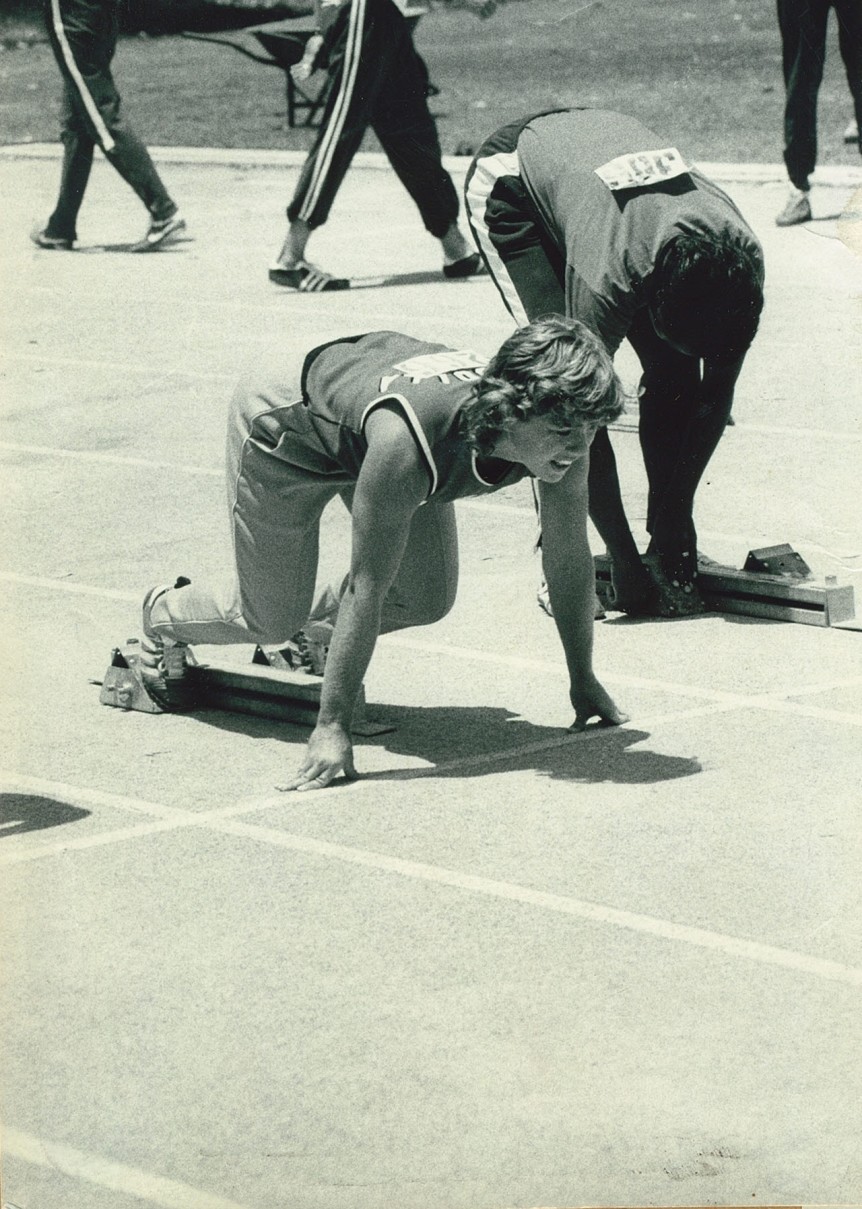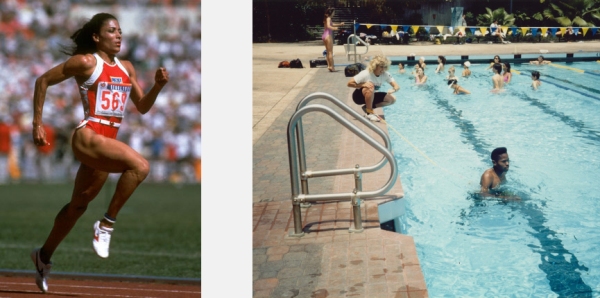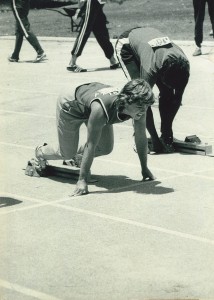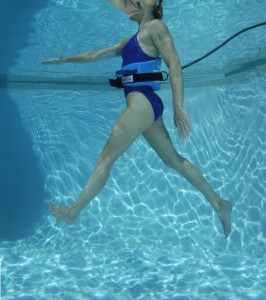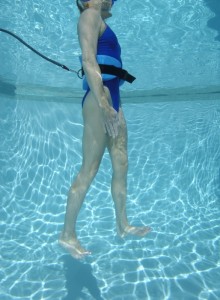Florence Griffith Joyner is the athlete who comes to mind whenever I work with anyone in a pool with a hamstring strain. Florence was nearly sidelined prior to her huge 1988 Seoul Olympics success with a “pulled” or strained hamstring. Since she was the fastest woman in the world, she set the bar pretty high as to what was possible to do in the water. I had her on an elasticized tether attached to a band around her waist. She sprinted in place with the other end of the tether around my ankle on the side of the pool. Florence was doing at the Beverly Hills YMCA pool what Danny Everett had been doing at the UCLA pool. (See photos above.)
Florence’s coach, Bobby Kersee, would tell me what Florence should have run on the track that day then I would translate that into time to get her the equivalent workout. For instance, if Florence should have run 6 x 200M, I would have her run 6 x 25 seconds. She would jog in place, ease into a strong stride and gradually work her way up to sprint speed. No sudden increases or decreases – that was safest for the hamstring. Rest a minute then repeat five times. When we got to 10-second sprints, her intense speed meant that she could put down 28 left/right steps in ten seconds. No one else has come close in all my years.
I, too, am a veteran when it comes to hamstring strains. I must have had at least a dozen over the years – some severe, some relatively mild. But they all stop you from what you were doing. Then what?
I get in the pool right away. Quite honestly, I get in the pool no matter what kind of injury I have. It lets me move, it lifts my spirits, and it lets me work out new protocols for our patients. So here it is: the protocol I created today in the pool for my own hamstring muscles. It’s not for an Olympic sprinter. It’s for a Baby Boomer who wants to keep going to the UCLA track to enjoy running with her running partner of the past 20 years.
Rule #1. Don’t stretch it! Leave it alone for the first week or two. Just do what you can do in terms of movement, but stop testing it out. Remember when you were a kid and they’d tell you, “Don’t pick at it?” Well, same thing here. Leave it alone and let it get some healing time first.
Rule #2. Ease into every movement very slowly. Sudden moves are what will re-injure the hamstring, so start very slowly and if everything feels fine, begin to gradually (very gradually) pick up speed. With hamstrings, you’re trying to “get away with it.” You’re trying to sneak some work into them without them complaining, doing it in the water is the easiest way.
Put on a flotation belt and get into some deep water. Since I wanted as much control as possible of my movements, I chose to put on a tether and stay in one place in the pool instead of move around. I started slowly with Deep-Water Running.
This technique does only the back half of the running motion, so it doesn’t put the same kind of stress on the hamstrings that running on land does where the lower leg and foot reach forward. Still, I started cautiously, even though I’ve helped many Olympic sprinters, jumpers, and hurdlers through their hamstring strains successfully. I’m always cautious at first. Find out slowly what does and doesn’t hurt and choose the exercises accordingly.
It felt good! So I kept doing it, gradually increasing the speed up to a strong moderate pace that I could hold for five minutes. By then all discomfort in the muscle was gone, so I was a bit emboldened. I started a Power Walk very slowly, actually expecting it to hurt and have to stop.
But it didn’t hurt. I gradually went from super slow to a more comfortable, relaxed pace. I kept my knees slightly bent in case that forward reach with my right leg would aggravate the right hamstring. It did not. I kept going with Power Walk for five minutes.
Normally, I mix up the Deep-Water Interval techniques every 30 seconds or every minute, but when dealing with an injury, I’ve learned not to switch the movements so quickly since sudden changes can hurt more.
Next I tried out Speed Walk to see if I could even do it.
At first I felt vulnerability in that hamstring, but then I tightened up the form – abs pulled in tight, butt muscles as tight as possible, knees absolutely straight so the hamstrings wouldn’t be working but all the work would go to the gluts. It worked, and I felt solid and strong doing Speed Walk. Three minutes of that was enough.
In a pool therapy session stretching is what comes next and I cautiously placed my foot on the wall to see if I assume the hamstring stretch position without pain. I almost could. My knee was slightly bent to protect the hamstring and all was well. But then when I tried to sway from side to side as I usually enjoy doing to stretch the inner and outer edges of the upper hamstrings, my leg yelled “STOP!” I had violated my own rule of not testing a strained hamstring. It had been only six days since the injury and that wasn’t long enough.
Rule #3. Go back to what was feeling good just before you hurt it. That’s a rule of rehab that I’ve learned over and over so many times. I did another three minutes of Deep-Water Running, three minutes of Power Walk, and one minute of Speed Walk. Whew, it was feeling better again.
Rule #4. Skip any movement or exercise that hurts. Simply that. If it hurts, don’t do it.
Next came the Kicking Series, and just the thought of doing most of them didn’t feel right. I did a half-hearted, slow back flutter kick, an equally slow bicycle then gave up on kicking.
Rule #5. Don’t step over the “Red Line.” For me, the Red Line is where the range of motion feels OK and then suddenly it doesn’t feel OK anymore when you move just a fraction beyond that. Every injury will start with a Red Line that’s pretty rigid and narrow. Then each day the Red Line will retreat just a little allowing for fuller, wider movement. I had stepped over my Red Line doing that stretch, so I needed to be careful not to do that during the rest of the water healing workout.
Down to the shallow end of the pool for the basic exercises that have seen me through thick and thin of ankle sprains, shoulder pain, back bruises from landing on a curb, and you name it – I’ve probably done it to myself and needed these exercises to get me through it. Lunges, Squat Jumps, Side Straddles, Front Straddles, V-Kicks, Double Heel Lifts, Leg Swings, and Front Kicks. Some felt better than others. I skipped any that didn’t feel right and I bent my right knee to take the strain off that hamstring on many. I tried running in chest-deep water, but when my foot hit the bottom of the pool it drove forces up the back of my thigh straight to the sore spot in the belly of the hamstring muscle. So I put on my float belt and did one more Deep-Water Running sequence. No forces, and the echo of pain receded.
Rule #6. Better to quit early than do one too many. One too many of anything. That was enough for the day. Except ice, of course. I’ll be icing off and on this evening, and will get back in the pool again tomorrow. From experience, I should be able to add an exercise or two with each day until I return to full fuction. That’s the long-range plan. For tomorrow, I won’t stretch the hamstring and I’ll expect the Red Line to be a little bit further away than it was today.
Lynda Huey, M.S., founder of CompletePT and Huey’s Athletic Network, is a former athlete and coach whose own injuries led her into the water to find fitness and healing. She was educated at San Jose State University where she starred on the track and field team during its golden years. Lynda is the author of four books on water exercise and water rehabilitation.

